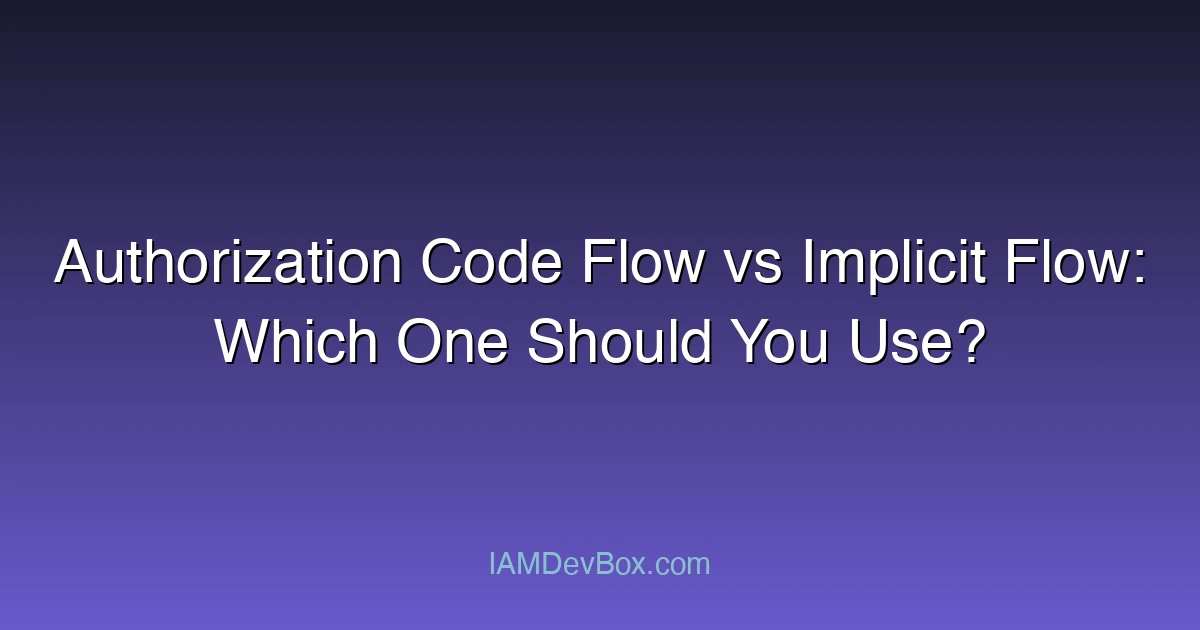Visual Overview:
sequenceDiagram
participant User
participant App as Client App
participant AuthServer as Authorization Server
participant Resource as Resource Server
User->>App: 1. Click Login
App->>AuthServer: 2. Authorization Request
AuthServer->>User: 3. Login Page
User->>AuthServer: 4. Authenticate
AuthServer->>App: 5. Authorization Code
App->>AuthServer: 6. Exchange Code for Token
AuthServer->>App: 7. Access Token + Refresh Token
App->>Resource: 8. API Request with Token
Resource->>App: 9. Protected Resource
OAuth 2.0 offers multiple authorization flows to suit different application types and security requirements. Two of the most discussed flows are the Authorization Code Flow and the Implicit Flow. Understanding their differences, strengths, and weaknesses is essential for developers and architects designing secure and efficient authentication systems.
Overview of Authorization Code Flow and Implicit Flow
The Authorization Code Flow is designed primarily for server-side applications where the client secret can be securely stored. It involves an intermediate authorization code, which the client exchanges for an access token via a backend server. This adds a layer of security by preventing tokens from being exposed in the browser or user-agent.
In contrast, the Implicit Flow is intended for public clients, such as single-page applications (SPAs), which cannot securely store client secrets. It directly issues tokens to the client via the browser without the intermediate code exchange, aiming to simplify the process but at some security cost.
Step-by-Step Comparison
| Step | Authorization Code Flow | Implicit Flow |
|---|---|---|
| User authenticates | Redirected to authorization server, user logs in | Same as Authorization Code Flow |
| Authorization code returned | Code sent to client backend via redirect | No code; access token returned directly in redirect |
| Token exchange | Backend exchanges code securely for access token | Token is exposed to the browser |
| Token storage | Tokens stored securely on backend | Tokens stored in browser (more vulnerable) |
Security Implications
Authorization Code Flow benefits from server-to-server token exchanges, minimizing token exposure to browsers or malicious scripts. When combined with PKCE (Proof Key for Code Exchange), it significantly mitigates risks such as authorization code interception and replay attacks.
The Implicit Flow exposes tokens directly to the browser, making them more susceptible to attacks like token leakage via browser history, cross-site scripting (XSS), or interception by malicious browser extensions. Because of these vulnerabilities, OAuth 2.1 deprecates the Implicit Flow in favor of Authorization Code Flow with PKCE, even for public clients.
When to Use Authorization Code Flow
- Applications with a backend server capable of securely storing secrets
- Web applications requiring enhanced security and long-lived tokens
- Scenarios where refresh tokens are needed
- Any modern application aiming for compliance with the latest OAuth 2.1 recommendations
When to Use Implicit Flow
- Historically used by single-page applications without a backend
- Now generally discouraged due to security concerns
- Considered only for legacy systems unable to adopt Authorization Code Flow with PKCE
Code Example: Authorization Code Flow with PKCE
// Example using Spring Security OAuth2 client for Authorization Code Flow with PKCE
@Bean
public SecurityFilterChain securityFilterChain(HttpSecurity http) throws Exception {
http
.oauth2Login(oauth2 -> oauth2
.authorizationEndpoint(authorization -> authorization
.authorizationRequestResolver(
new CustomAuthorizationRequestResolver(clientRegistrationRepository))
)
.tokenEndpoint(token -> token
.accessTokenResponseClient(new NimbusAuthorizationCodeTokenResponseClient())
)
);
return http.build();
}
This snippet highlights how modern frameworks facilitate the Authorization Code Flow with PKCE, abstracting complexities while maintaining robust security.
Real-World Use Cases
-
Google OAuth 2.0 API mandates Authorization Code Flow with PKCE for its web and mobile apps to ensure tokens are never exposed in the browser.
-
ForgeRock Identity Cloud supports Authorization Code Flow as a standard for its hosted login journeys, enabling customizable and secure user authentication.
-
Legacy SPAs that still use Implicit Flow are increasingly migrating to Authorization Code Flow with PKCE for better security.
Key Questions to Consider
- Does your client application have a secure backend to handle token exchanges?
- Are you managing sensitive scopes or long-lived tokens that require refresh tokens?
- Is your application prepared to implement PKCE to enhance security?
- How do you plan to mitigate risks associated with token exposure if using a public client?
Conclusion
The Authorization Code Flow, especially when combined with PKCE, is the recommended approach for nearly all modern OAuth 2.0 implementations due to its superior security profile. The Implicit Flow, while simpler, presents risks that are no longer acceptable in most security-conscious environments. If you’re designing or upgrading an authentication system today, prioritize Authorization Code Flow with PKCE for both public and confidential clients.
👉 Related: Understanding the Authorization Code Flow in OAuth 2.0
👉 Related: Understanding the Authorization Code Flow with PKCE in OAuth 2.0
